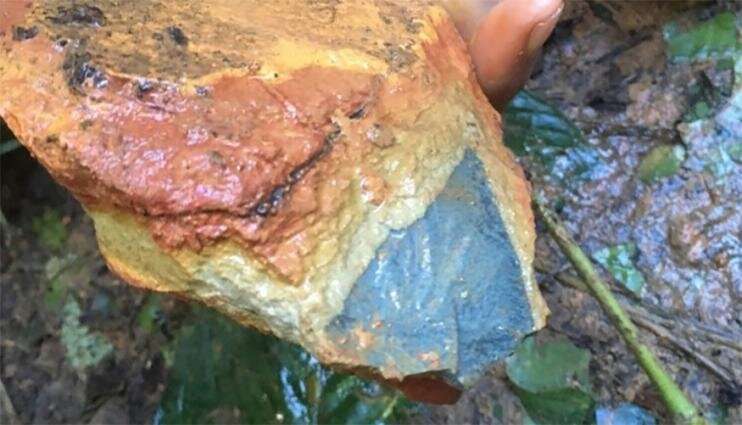How the secret world of soil microbes helps keep carbon in the ground

The largest terrestrial carbon sink on earth is the planet's soil. One of the fears that many scientists have is that a warming planet will liberate significant portions of the soil's carbon, turning it into carbon dioxide (CO2) gas, and so further accelerate the pace of planetary warming. One of the key players in this story is the microbe: Invisible, and yet the predominant form of life on earth.
"Microbes are everywhere and in everything," says Kristen DeAngelis, professor of microbiology at the University of Massachusetts Amherst and senior author of the study, recently published in ISME Communications. "There are billions of microbes in one teaspoon of soil; a trillion times more microbes than stars in the known universe. And yet, we don't know that much about them."
It seems that microbial activity has a large effect on the atmosphere, especially in how microbes help convert organic carbon—think of all the fallen leaves, rotting tree stumps, grasses and other organic matter—into soil, keeping that carbon out of the atmosphere. It's this soil organic matter, or SOM, that acts not only as a carbon sink but also gives soil its ability to absorb water and prevent flooding as well as to be a nutritious source of energy for plant life.
And yet, it's not entirely clear how microbes form SOM. "Our study sheds light on the relevance of microbial community composition and activity to shape the composition of SOM," says lead author Luiz A. Domeignoz-Horta, now at the University of Zurich's department of evolutionary biology and environmental studies, but who completed his research for this paper as part of DeAngelis's lab at UMass Amherst. "Before our study, no one knew that the particular composition of microbial communities was important for the formation of SOM."
The team conducted an experiment in which they inoculated "model soils," or sterile mixtures of sand and clay, with different microbial communities, and then fed the microbes sugars and vitamins so that they could grow over the course of four months, building SOM the whole time. The group was then able to measure the SOM generated by these different communities, as well as to test how persistent the SOM was depending on the microbial community that created it.
To do this, the team subjected the soils to a controlled process of pyrolysis—or heating, up to 650 O C, in the absence of oxygen. "As we heated the soils, we recorded when the soil began to release carbon gas. More 'thermally stable' samples of SOM reached temperatures above 400O C, while the less thermally stable samples emitted more carbon in the 200—300O C range," says Domeignoz-Horta, who led the team's international collaboration. "This assay was performed by our soil biochemists' collaborators in Switzerland, and it is a great example of the importance of a multidisciplinary research team to advance science," observes Domeignoz-Horta.
What the researchers discovered is not only further evidence linking microbes to SOM formation, but that different microbial communities shaped the composition of SOM in distinct ways, including the SOM's ability to withstand being turned into CO2. While it seems that bacteria are primarily responsible for driving the creation of SOM in this model system, it is the presence of fungal communities that render soil able to withstand warming temperatures.
"I see this invisible world of bacteria and fungi, the microbial world, everywhere," says DeAngelis. "Most microbes help us, and we need to know more about them to ensure the health, safety and wellbeing of our own world."Microbiologists clarify relationship between microbial diversity and soil carbon storage
More information: Luiz A. Domeignoz-Horta et al, Direct evidence for the role of microbial community composition in the formation of soil organic matter composition and persistence, ISME Communications (2021). DOI: 10.1038/s43705-021-00071-7
Provided by University of Massachusetts Amherst
Team finds that rock weathering boosts soil organic carbon storage

Rock weathering controls the potential for soil carbon storage at a continental scale.
New research from Lawrence Livermore National Laboratory (LLNL) and collaborators found that rock weathering—the process of chemical transformation by long exposure to water and the atmosphere—boosts soil organic carbon storage by altering soil mineralogy. The research appears in the journal Biogeochemistry Letters.
As rock-derived primary minerals weather to form soil, they create reactive, poorly crystalline minerals that bind and store organic carbon. By implication, the abundance of primary minerals in soil might influence the abundance of poorly crystalline minerals, and consequently soil organic carbon storage.
"We found that the link between primary mineral weathering, poorly crystalline minerals and soil carbon has not been fully tested, particularly at large spatial scales," said LLNL scientist and co-lead author Eric Slessarev. "To close this knowledge gap, we designed a model that links primary mineral weathering rates to the geographic distribution of poorly crystalline minerals across the U.S., and then used this model to evaluate the effect of rock weathering on soil organic carbon."
The team found that poorly crystalline minerals are most abundant and strongly correlated with organic carbon in geographically limited zones that experience enhanced weathering rates, particularly where humid climate and plenty of primary minerals co-occur. This finding confirms that rock weathering alters soil mineralogy to enhance soil organic carbon storage at continental scales, but also indicates that the influence of active weathering on soil carbon storage is limited.
Most of the terrestrial biosphere's carbon is stored below ground as soil organic carbon (SOC). Small changes in the relative size of the global SOC pool can influence atmospheric CO2 levels, and hence global climate. But in most soils, a significant fraction of SOC is associated with minerals that limit its rate of exchange with the atmosphere.
The team identified a quantitative relationship between primary mineral weathering rates and stocks of poorly crystalline minerals (PCM) that accounts for both climate and the availability of readily weathered minerals. Team members also tested the role of primary mineral weathering contributing to carbon storage at continental scales.
Primary mineral weathering rates, PCM stocks and carbon storage are linked because poorly crystalline minerals are relatively transient weathering products. Studies of soil age gradients show that these minerals accumulate during the initial stages of weathering but later decline as the stock of primary minerals is exhausted and PCMs ripen into less reactive crystalline secondary minerals. Across rock types, these minerals are most abundant in soils formed from volcanic parent materials rich in feldspars and glass with feldspar-like composition and in humid climates, where ample water facilitates higher weathering rates.
"Taken together, these facts indicate that the primary mineral weathering rate is a key factor that determines the abundance of PCMs," said LLNL scientist and co-author Jennifer Pett-Ridge. "PCMs disappear over time as they ripen into more crystalline minerals; so additional active weathering is required to maintain soil PCMs and lead to the conditions needed for heightened carbon storage."
LLNL researchers Noah Sokol and Erin Nuccio also contributed to the research.
Getting to the root of carbon storage in deep soils
More information: Eric W. Slessarev et al, Rock weathering controls the potential for soil carbon storage at a continental scale, Biogeochemistry Letters (2021). DOI: 10.1007/s10533-021-00859-8
Provided by Lawrence Livermore National Laboratory
No comments:
Post a Comment